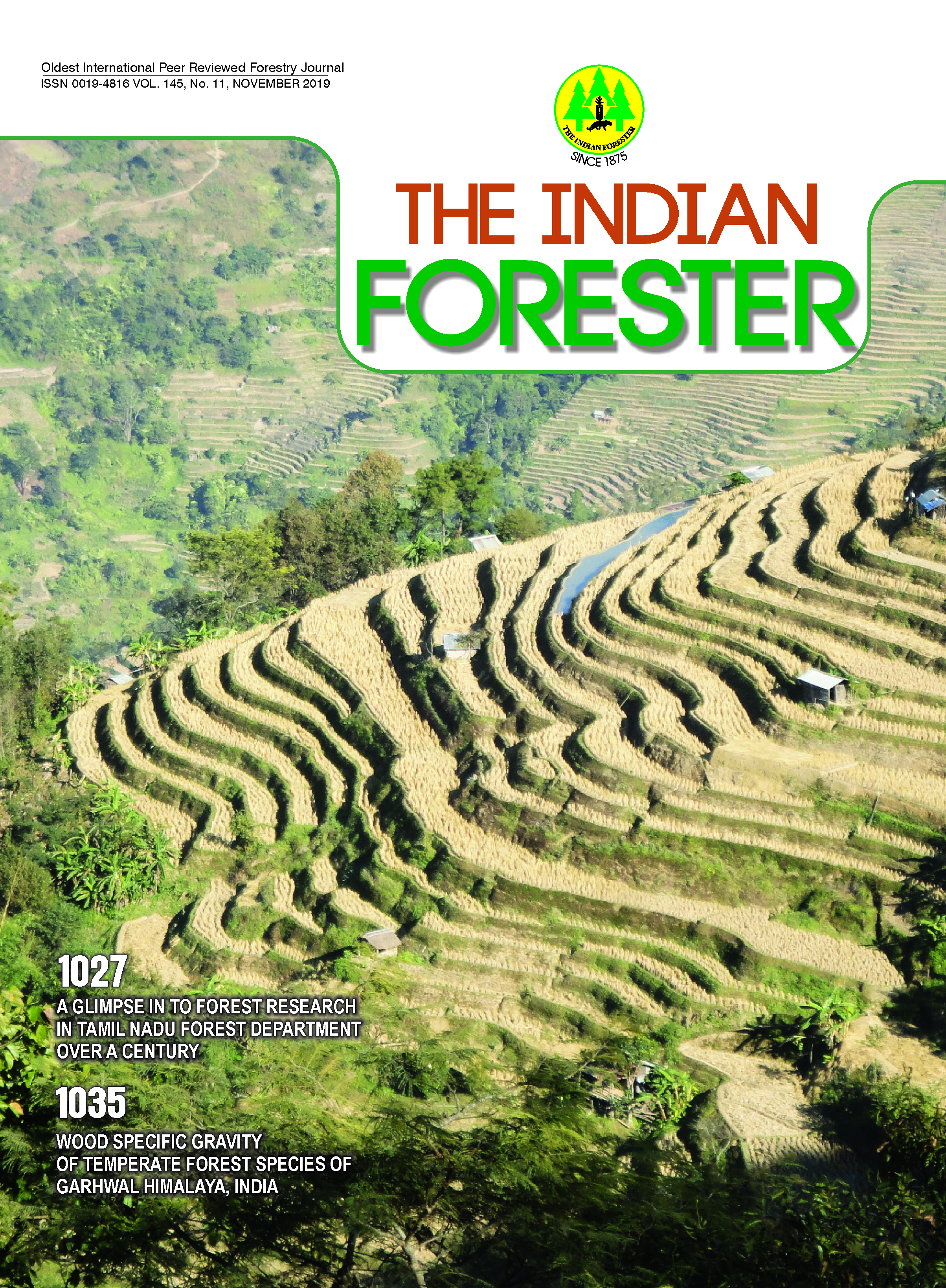Variations in Certain Wood Quality Parameters of Melia dubia Cav
DOI:
https://doi.org/10.36808/if/2019/v145i11/149924Keywords:
Melia dubia, Wood Parameters, Genetic Analysis, Heritability, Genetic Gain.Abstract
Melia dubia Cav. has established as an alternate species under various agro-forestry systems. Consequently plantation area has increased substantially over the years, particularly under irrigated conditions. The species not only has wider adaptability across geographical regions over varying soil types but has also been reported to be productive with clear bole and merchantable biomass. Therefore, analysis of certain wood properties for varying genetic resources of species was conducted at Forest Research Institute, Dehradun for screening quality planting stock of the species so to enable growers to choose planting stocks with known wood parameters. The wood samples were collected from thirty nine genotypes of thirteen progenies and subjected to analyze growth and wood traits. All the progenies had significant variations for all growth and wood parameters. Specific gravity and fiber length were found to be the most important parameters for heritability. The progenies were grouped into five clusters, though Cluster V had maximum number of progenies (5), cluster one was found to be most productive for growth and wood parameters. Correlation analysis reveals no significant relationship among the growth and wood quality parameters, hence it could be inferred that further propagation of superior trees can be done based on wood quality parameters only, without considering the growth traits.References
Abu-Alrub I., Christianson J.L., Madsen S., Sevilla R. and Ortiz R. (2004). Assessing tassel, kernel and ear variation in Peruvian highland maize. Plant Genetic Resources Newsletter, 137:34-4.
Burley J. and Palmer R.R. (1979). Pulp and Wood densitometric properties of Pinus caribaea from Fiji. CFI. Occasional Paper No.-6, p 66.
Burton G.W. and Devane E.H. (1953). Estimating heritability in tall fecue (Festuca arundinaceae) from replicated clonal material. Agronomy Journal, 45:478-481.
Cardi T., Mazzei M. and Frusciante L. (2002). Field variation in a tetraploid progeny derived by selfing a Solanum commersonic (+) Solanum tuberosum somatic hybrid: A multivariate analysis. Euphytica, 124:111-119.
Chinnaraj S., Malimuthu C. and Subrahmanyam S.V. (2011). Development of micropropagation and mini cutting protocol for fast growing Melia, Dalbergia and Eucalyptus clones for pulpwood and bio-energy plantations. In: IUFRO Tree Biotechnology Conference Proceedings. pp 332-334.
Chudnoff M. and Geary T.F. (1973). On the heritability of wood density in Sweitenia macrophylla. Turrialba, 23: 359-361.
Dadswell H.E. (1957). Tree growth characteristics and their influence on wood structure and properties. Proceedings of 7th British Commonwealth Forestry Conference. CSIRO, Australia,p19.
Johanson H.W., Robinson H.F. and Comstock R.F. (1955). Estimation of genetic and environmental variability in Soybean. Agronomy Journal, 47: 314-318.
Khali, D.P., Kumar A. and Shrivastava P. (2017). Plywood for general purpose (interior grade) of selected different progenies of Melia composita Benth. J. Indian Acad. Wood Sci., 14(2):139-145.
Kumar A. (2007). Growth performance and variability in different clones of Gmelina arborea (ROXB.). Silv. Genet., 56: 32-36.
Kumar A., Parveen, Dobhal S., Sharma S., Ahmed N. and Rawat U.S. (2013). Genetic screening and improvement of Melia composita Willd. Ann. For., 21(2):189-196.
Kumar A., Savita., Shrivastava P., Sharma S., Dobhal S., Rana A. and Kumar R. (2017). Development of high yielding varieties of Melia dubia Cav. (Syn. Melia Composita Benth). Indian Forester, 143(11):1203-1206.
Lush I.L. (1949). Heritability of quantitative characters in farm animals. Proceedings of International Congress Genet Heriditas (Suppl), pp 356-387.
Miranda I., Gominho J., Lourenço A. and Pereira H. (2009). Variation of heartwood and sapwood in 18-year-old Eucalyptus globulus trees grown with different spacing. Trees – Structure and Function, 23:367–372.
Pande P.K., Kumar A., Ravichandran S., Naithani S., Kothiyal V., Kishore P.B.K., Raturi A., Gautam P., Dobhal S. and Sharma S. (2013). Genetic analysis of growth and wood variations in Leucaena leucocephala (Lam.) de Wit. J. For. Res., 24(3):485-493.
Panshin A.J. and Zeeuw de C.H. (1980). Textbook of wood technology. 4th ed. McGraw-W, New York, p 722.
Purkayastha S.K., Agrawal S.P., Farooqui P., Tandon R.D., Chauhan L. and Misra N. (1979). Evaluation of wood quality of Eucalyptus plantations in various states. Final Technical Report (Nov. 1 to Oct. 31, 1979) PL 480 Project no Inn FS-66. p 85.
Saravanan V., Parthiban K.T., Kumar P. and Marimuthu P. (2013). Wood characterization studies on Melia dubia Cav. for pulp and paper industry at different age gradation. Research Journal of Recent Sciences, 2:183–188.
Singh N.B. and Chaudhary V.K. (1992). Multivariate analysis of genetic divergence in wild apricot (Prunus armeniaca L.). Indian Journal of Forestry, 15(3):211-216.
Sukhatme P.V. and Amble V.N. (1989). Statistical methods for agricultural workers. Publication and Information Division, ICAR, New Delhi, pp 359.
Suprapti S., Djarwanto and Hudiansyah (2004). The resistance of five wood species against several wood destroying fungi. J Peneli Hasil Hutan, 22(4): 239-246.
TAPPI. Standard and suggested methods (1980). Technical Association of Pulp and Paper Industry, New York, pp 200-265.
Tunctaner K. (2002). Primary selection of willow clones for multipurpose use in short rotation plantation. Silvae Genetica, 51:105-112.
Uday D.N., Sujatha D., Pandey C. (2011). Suitability of Melia dubia (Malabar Neem) for plywood manufacture. J Indian Acad Wood Science, 8(2):207-211.
Wang X.C. and Zhang J.L. (1984). Studies on plus tree selection of Larix leptolepis and methods of quality grading. Forest Science and Technology, 4:4-6.
Wardrop A.B. (1969). Fiber morphology and paper making. TAPPI J, 52(3):396.
Zobel B.J., Van Buijtenen J.P. (1989). Wood Variation: Its Cause and Control. Springer Verlag, New York, p 363.
Downloads
Downloads
Published
How to Cite
Issue
Section
License
Unless otherwise stated, copyright or similar rights in all materials presented on the site, including graphical images, are owned by Indian Forester.





